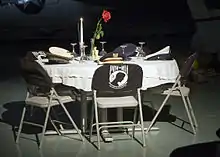Missing man table
A missing man table, also known as a fallen comrade table,[1] is a ceremony and memorial that is set up in military dining facilities of the United States Armed Forces and during official dining functions, in honor of fallen, missing, or imprisoned military service members.[2] The table serves as the focal point of ceremonial remembrance, originally growing out of US concern of the Vietnam War POW/MIA issue.[3][4]
Observance
The missing man table may be a permanent display in dining facilities, and is also traditionally part of military dining-in ceremonies and service balls. The ceremony may also be performed in conjunction with Veterans Day and Memorial Day services.[5][6]
Description

The missing man table consists of the following elements:
- A small table set for one, symbolizing the isolation of the absent service member. The table is usually set close to, or within sight of, the entrance to the dining room. For large events, the missing man table may be set for six places representing each of the five armed services (Army, Navy, Marine Corps, Air Force, and Coast Guard), with the sixth symbolizing the civilians who died during armed conflict.[7] The table is round to represent the everlasting concern the survivors have for the missing.[8]
- One or more head covers may be placed upon the table to represent the armed service of the missing persons.[9]
- A white tablecloth to symbolize the pure intentions of the service members who responded to the country's call to arms.[10]
- A single rose in the vase symbolizing the blood that service members have shed in sacrifice to ensure the freedom of the United States of America. This rose also represents the family and friends who keep the faith while awaiting the return of the missing service members.[11]
- The red ribbon represents a love of country that inspired the service members to serve the country.[12]
- A slice of lemon on the bread plate that represents the bitter fate of the missing.[13]
- Salt sprinkled on the bread plate that symbolizes the tears shed by waiting families.[13]
- An inverted glass to represent the fact that the missing and fallen cannot partake.[11]
- A lit candle symbolizes a light of hope that lives in hearts to illuminate the missing's way home.
- An empty chair to represent the absence of the missing and fallen[14]
The elements are tradition, not prescribed. Individual displays may differ depending on the availability, practicality, and appropriateness of the various elements in a particular venue. For instance, private displays by individuals or groups will often include a Bible. The inclusion of the Bible in public (publicly funded installations) displays has been challenged due to violations of the First Amendment and DoD Instruction resulting in its removal.[15]
References
- KATHY KEIRSEY (1999). GUIDE TO THE MILITARY DINING-IN (PDF). NEW YORK: CADET HOSTESS OFFICE CULLUM MEMORIAL HALL WEST POINT.
- Larry Shaughnessy. "POW/MIA day brings somber ceremony, one quietly symbolic tradition". CNN.
- "Lackland honors former POWs with new-look ceremony". www.afisr.af.mil. Archived from the original on 2013-03-13. Retrieved 2013-03-03.
- Gerry J. Gilmore. "'Missing Man' Ceremony Honors Prisoners of War, Missing in Action". American Forces Press Service. Archived from the original on 2012-04-14.
- "ALMAR 020/07". 11 April 2007. Archived from the original on 2008-09-05.
- "West Point Army Birthday Celebration".
- Bannerman, Stacy (2006). When the war came home: the inside story of reservists and the families they leave behind. Continuum International Publishing Group. p. 178. ISBN 978-0-8264-1795-4.
missing man table.
- "Missing Man Table and Honors Ceremony (instructions)" (PDF). www.dtic.mil. Archived from the original (PDF) on April 25, 2012.
- "Beale honors POW/MIA Recognition Day". Archived from the original on 2013-02-24. Retrieved 2013-03-03.
- "EVENT: AFSA POW/MIA Recognition Day Ceremony" (PDF). Archived from the original (PDF) on 2010-12-26. Retrieved 2013-03-03.
- "POW – MIA Manual" (PDF). The American legion Department of Florida. Archived from the original (PDF) on 2012-04-17. Retrieved 2013-03-03.
- "The POW/MIA Table: A Place Setting for One, A Table for All". Navy Live. Archived from the original on 2016-12-03. Retrieved 2016-11-30.
- "Pow-Mia Ceremony". Archived from the original on 2013-03-10. Retrieved 2013-03-03.
- Lisa R. Rhodes (November 8, 2012). "Veterans honored at annual Fort Meade luncheon".
- Burke, Matthew (2018-04-07). "Advocacy Group Wants Bible Removed from POW/MIA Display". Military.com. Archived from the original on 2021-09-08. Retrieved 2021-09-08.
External links
 Media related to Missing man table at Wikimedia Commons
Media related to Missing man table at Wikimedia Commons
